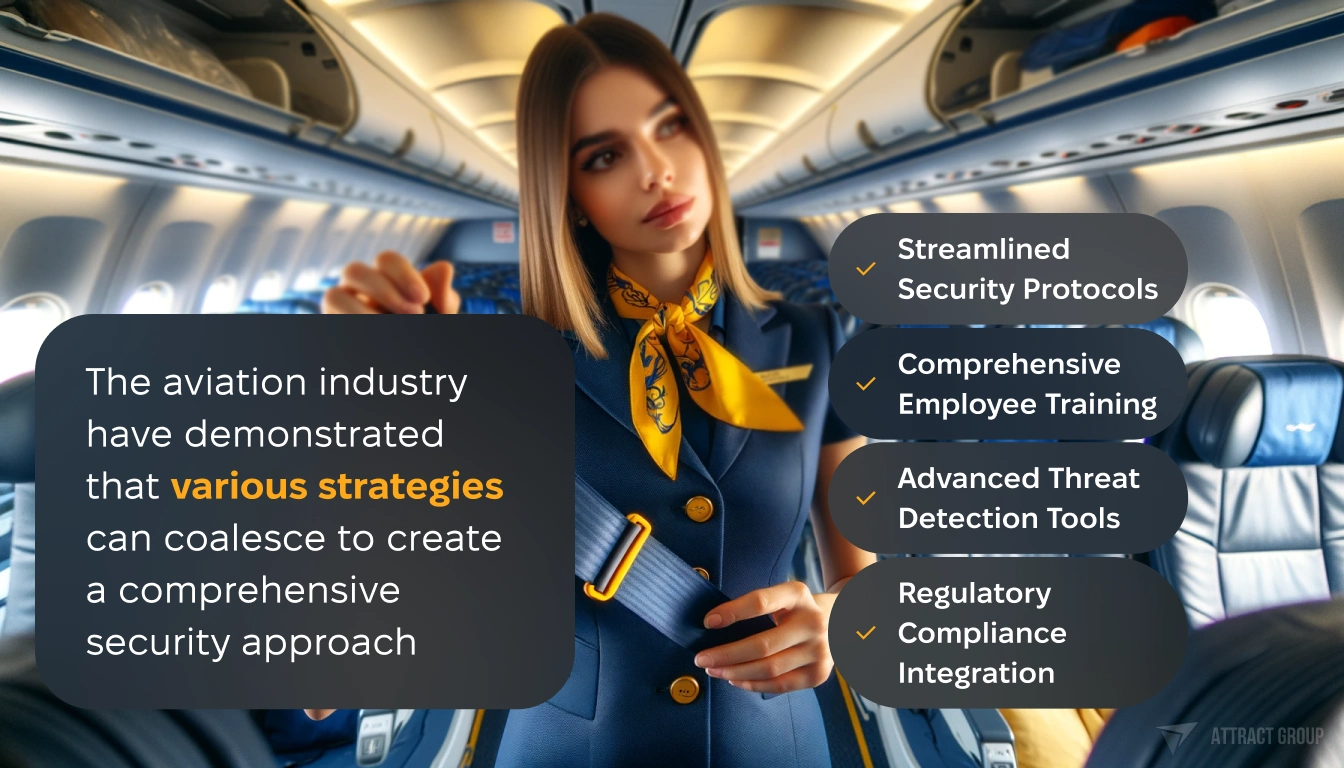Enhancing Airplane ERP Data Security: US Standards & Techniques
 2 January 2024
2 January 2024? Listen to the Summary of this article in Audio
The digital integration of Enterprise Resource Planning (ERP) in aircraft manufacturing is a testament to the relentless pursuit of operational excellence and innovation in the aviation industry. As companies navigate through the complex matrix of global competition and stringent regulatory environments, the significance of robust Airplane ERP Data Security has skyrocketed. By aligning with US standards for ERP security, these sophisticated data systems ensure the protection of sensitive industry information against prevailing cyber threats. Furthermore, employing advanced aviation data protection techniques has become an indispensable facet of the manufacturing process, fortifying the security framework against vulnerabilities and infiltrations.
Ensuring stringent aircraft ERP security measures are in place has become paramount, not only to shield company data but also to uphold the integrity of the highly competitive and fast-paced aviation industry. This necessity propels the continuous evolution of ERP cybersecurity for the aviation industry, creating a bulwark that safeguards the cornerstone of aerospace innovation and reliability.
Key Takeaways
- ERP systems in aviation are pivotal for operational excellence and sustainable growth.
- Aircraft ERP security measures are critical for protecting sensitive aviation industry data.
- US standards for ERP security embody rigorous criteria to ensure robust data protection.
- Implementing advanced aviation data protection techniques is crucial against dynamic cyber threats.
- ERP cybersecurity is a strategic imperative for fortified defense in the aviation industry.
Have our experts evaluate your systems and provide recommendations to fortify your data protection.
Understanding Airplane ERP Data Security Challenges in the Aviation Industry
The aviation sector’s unparalleled complexity and the sheer volume of sensitive data it handles daily pose airplane ERP data security challenges that are unique and formidable. As the industry strives to protect aviation ERP data, it encounters an array of data risks intrinsic to the nature of its operations. Navigating the turbulent skies of aviation industry data risks requires a vigilant approach to securing airplane data systems, underpinned by a deep understanding of the challenges at hand. This section examines these obstacles and the imperatives they create for ERP security in aviation.

The intricacies of aviation ERP data security reflect a need to juggle the management of intricate supply chains along with compliance to rigid industry regulations while ensuring that accuracy and operational efficiency remain uncompromised. Each element, from component assembly to flight operations, demands a thread of continuity—secure information flow that ERP systems are expressly designed to manage.
The imperviousness of ERP systems against security threats is not solely a matter of digital protection; it is an absolute business imperative in safeguarding the aerospace sector’s pulse.
Consider the following table, which outlines core security challenges associated with the vast ERP systems in the aviation sector:
| Challenge | Description |
|---|---|
| Complexity | Robust ERP systems amalgamate data across multifaceted platforms, requiring advanced security protocols to mitigate risks of breaches. |
| Regulatory Compliance | Stringent international standards necessitate comprehensive data management capabilities within ERP systems to ensure adherence. |
| Data Accuracy | Precision is paramount; hence ERP systems must ensure the integrity and veracity of data to avoid costly operational errors. |
| Operational Efficiency | In an industry where time equates to extensive costs, ERP systems are integral in maintaining an efficient flow of operations. |
Within these categories, myriad risks manifest, each capable of crippling systems and causing rippling effects across global operations. Closure scrutiny reveals:
- Hackers’ increasingly sophisticated methods to exploit vulnerabilities within aviation ERP systems.
- Internal threats, wherein the compromise might originate from within an organization, deliberately or inadvertently.
- The interconnectivity of the aviation industry’s global network, amplifying the impact of a singular security breach.
- An ever-expanding arsenal of regulatory requirements that necessitate frequent upgrades and vigilance within ERP data protocols.
Facing these challenges is not optional; it is essential for maintaining the industry’s integrity and operational readiness. It calls for a resilient stance to protect aviation ERP data, employing not merely defensive but proactive measures to safeguard the sanctum of aviation operations. Failure to address these data security challenges robustly risks compromising the efficiency and reliability of workflows critical to this sector’s thriving pulse.
The Role of US Standards in Strengthening Aircraft ERP Systems
In the quest for unbreachable airplane ERP data security, the role of US standards emerges as a fundamental keystone. These standards serve as a robust framework within which ERP systems in the aerospace sector are fortified, thereby achieving regulatory compliance in aviation ERP. Emanating from these standards are rigorous protocols that not only foster adherence to high-level security practices but also reinforce the operational resilience of ERP infrastructures against cyber threats.

Adhering to US standards for aircraft ERP systems involves a convergence of customization and standardization. This balance is necessary to accommodate the intricate requirements of the aerospace industry while also ensuring the streamlined operations that standardization affords. The synergy between the two enables aerospace companies to leverage the efficiency of ERP systems fully, while also establishing a compliance-aligned, secure operational environment.
Illustrating the importance of regulatory compliance in aviation ERP, the following table delineates the specific areas of focus that US standards underscore, ensuring that aerospace companies can navigate the multifaceted demands of security and compliance:
| Area of Focus | US Standards Impact | Outcome for ERP Systems |
|---|---|---|
| Data Protection | Provide guidelines for secure data management | Secure handling and storage of critical data |
| Access Control | Enforce rigorous access restrictions | Prevent unauthorized system entry |
| Incident Response | Dictate procedures for security breaches | Swift and effective response to threats |
| Continuous Monitoring | Mandate ongoing surveillance of ERP systems | Persistent security oversight and threat detection |
| Compliance Documentation | Require meticulous record-keeping practices | Evidence-based compliance assurance |
These standards, rooted in the ethos of aviation industry security standards, provide a scaffold that elevates the robustness of ERP systems, subjecting them to the highest benchmarks of data security and system integrity. By doing so, they procure a competitive edge for aerospace manufacturers that is harmonized with international security imperatives.
Optimizing enterprise resource systems in alignment with rigorous US standards and best practices is essential. It leads to strengthening airplane ERP data security at its core, allowing the aerospace industry to scale new heights in technological trust and reliability.
- Integration with Global Standards: Assimilating US practices with international regulations to achieve a global data security front.
- Operational Effectiveness: Balancing customization with standards for maximized efficiency and minimum disruption.
- Continuous Adaptation: Encouraging aviation ERP systems to be agile amidst evolving cyber threats and regulatory landscapes.
At the intersection of security and innovation, US standards embody a cardinal gateway to the future of aviation ERP systems—where rigorous defense mechanisms and a perpetual state of compliance readiness propel the aerospace sector forward. The result is a fortified bulwark that not only preserves the integrity of sensitive data but also augments the efficacy and adaptability of the ERP systems pivotal to aerospace excellence.

Key Techniques for Protecting Aviation ERP Data
The persistent threat of cyber-attacks on the aviation industry’s data systems accentuates the need for robust aviation ERP data encryption and stringent ERP access control systems. These measures not only form the bedrock of airplane data system security but are also instrumental in preserving the confidentiality, integrity, and availability of critical information.
Data Encryption and Access Control Systems
To thwart unauthorized access and potential data breaches, aviation ERP data encryption is employed to encode data, rendering it unintelligible to all except those who possess the correct decryption keys. Sophisticated encryption algorithms are essential to protect data both at rest and in transit throughout the aviation industry’s vast digital networks.
In conjunction with encryption, ERP access control systems ensure that only specified personnel have access to the ERP data they are authorized to handle. These systems leverage user identities and roles, pinpointing exact access privileges across the ERP suite, thereby diminishing the risk of internal and external breaches.
With aviation ERP data encryption and access control systems, we nurture an impenetrable shield around aviation data, setting a new standard for ERP security in the digital age.
Regular ERP Cybersecurity Assessments
The reactive nature of traditional cybersecurity is no longer tenable in the fast-paced aviation sector. Regularly scheduled ERP cybersecurity assessments are pivotal in evaluating and enhancing system vulnerabilities proactively. These assessments encompass a comprehensive examination of the ERP framework, detecting any potential weak links and instigating necessary fortifications ahead of exploit.
Audits such as aviation data protection audits further buttress the security of ERP systems, ensuring adherence to compliance and leading cybersecurity standards. It is only through perpetual vigilance and continuous improvements that organizations can maintain robust ERP cybersecurity in aviation—a testament to the resolute commitment aviation businesses have towards data protection.
Employing proactive ERP security measures and conducting regular aircraft ERP security evaluations form a perpetual cycle of enhancement, crafting a dynamic defense against a landscape of ever-evolving cyber threats.
Employee Training and Awareness Programs
No ERP system, regardless of its complexity or sophistication, can perform optimally without the support of a knowledgeable workforce. That’s why ERP employee training stands as a critical pillar in cultivating aviation ERP security awareness. Educating the aviation workforce on the nuances of ERP data protection is crucial in cultivating secure ERP practices.

Comprehensive training and awareness programs underline the workforce role in ERP security, enabling employees to recognize and respond to security incidents swiftly. Organizations that proactively engage in these practices ensure that every member of the team acts as a vigilant sentinel, safeguarding the ERP system against infiltration and misuse.
- Enhanced knowledge of data security protocols through ongoing ERP employee training.
- Encouragement of aviation ERP security awareness paves the way for preventive actions.
- Fostering a culture that values the significance of ERP data security in each organizational role.
In culmination, the synchronization of sophisticated security technology with a well-informed and vigilant workforce forms a formidable defense mechanism against data breaches. It is this union of skill and technology that serves as the bulwark of protection for the aviation industry’s ERP systems—an industry that continuously pushes the frontiers of what is secure in today’s digital world.
Adopting a Proactive Approach to Securing Airplane Data Systems
In the zeitgeist of aviation industry modernization, the imperative for proactive airplane data security has never been more pronounced. The advent of sophisticated ERP systems within the airplane manufacturing and maintenance spheres not only streamlines operations but also magnifies the potential cyber risks involved. This clarion call for an anticipatory stance necessitates anticipatory ERP security measures, enveloping the entirety of an ERP system’s lifecycle with holistic security layers.
Initiating protective ERP security strategies in aviation involves a foresight-driven paradigm shift, where traditional reactive postures give way to aviation industry data safeguarding strategies that are embedded at the inception of data system design and perpetuated throughout operational processes. This approach not only aligns with best practices but also serves as a beacon for aspirational security benchmarks across the aviation sector.
Aviation industry experts assert that the infusion of anticipatory planning and rigorous security frameworks drastically enhances the reliability and resilience of ERP systems against imminent cyber threats.
- The assimilation of real-time threat intelligence to inform ongoing ERP system security improvements.
- The integration of risk management principles and strategies across ERP functionalities.
- Investment in cutting-edge security technologies, aimed at pre-empting cyber incursions.
A cornerstone supporting such proactive advancements is the Security Management System (SeMS) framework, which provides structured guidance for aviation entities to undertake. SeMS advocates for strategic alignment between security measures and business objectives, thereby encouraging an environment of continuous improvement and adaptability to emerging threats.
| Proactive Security Component | Benefits |
|---|---|
| SeMS Adoption | Instills a robust security infrastructure, primed for adaptive response to threats. |
| Early Threat Detection | Provides a temporal advantage in responding to and mitigating risk exposure. |
| ERP System Hardening | Bolsters system defenses against both known and emerging vulnerabilities. |
| Comprehensive Employee Training | Equips the human asset to recognize and prevent potential security breaches. |
| Incident Response Planning | Ensures a prepared and practiced approach to any realized infractions. |
Embracing proactive airplane data security thereby transcends beyond a mere adherence to regulations—it emerges as a strategic enabler that can significantly uplift an organization’s security posture and safeguard the aviation industry’s critical data assets from the ground up.
Custom Software Development: Tailoring Security for Aviation Needs
In an era where the aviation industry faces unprecedented challenges, custom software development for aviation has become an essential instrument in crafting robust and resilient systems. Tailoring ERP security solutions to precisely fit the unique demands of aerospace manufacturing and operations is not merely advantageous; it’s a strategic imperative.

For an industry that deals with complex aerospace manufacturing processes and stringent compliance requirements, aviation-specific ERP systems bring forth a compelling array of benefits. These systems provide an invaluable means by which to navigate the multifaceted maze of aviation regulations, manage intricate supply chains, and assure that scalability is a given, not a luxury.
Bespoke aviation data security solutions, developed through custom programming and design, stand at the forefront of this digital transformation. The development of such systems is not only about protecting data but also about refining operational performance and crafting a competitive advantage in a fiercely contested marketplace.
By embracing the meticulous design of tailored ERP security solutions, aviation companies are investing in an infrastructure that is resilient to cyber threats, compliant with regulations, and optimized for growth.
To better appreciate how custom development is redefining the landscape, let’s delve into the tangible advantages:
- Fit-for-Purpose Security: Unlike off-the-shelf software, custom ERP solutions are built from the ground up with the primary objective of meeting the specific security needs and requirements of the aviation industry.
- Integrated Compliance: Such systems seamlessly embed compliance into the operational tapestry of the business, easing the rigorous adherence to international and domestic aviation standards.
- Scalable Architecture: Custom software is inherently scalable, designed to expand functionality as the business and its security needs grow, without disrupting existing processes.
- Enhanced Data Protection: Tailored encryption and access protocols ensure data remains secure against both external cyber threats and insider vulnerabilities.
We can further illustrate the effectiveness of customized ERP systems in aviation by examining their impact on operational dynamics:
| Operational Need | Custom ERP Solution Impact |
|---|---|
| Complex Manufacturing | Custom-built workflows are engineered to enhance manufacturing precision and time-efficiency. |
| Regulatory Compliance | Automated compliance tracking ensures real-time adherence to industry regulations. |
| Security Scalability | Adaptive security measures evolve in tandem with emerging cyber threats. |
| Cost Optimization | Strategic resource allocation driven by data analytics reduces operational expenses. |
Ultimately, the call for custom software development attests to the aviation industry’s need for systems that are not just protective barriers but also strategic assets. Systems that are robust enough to defend against today’s threats and agile enough to adapt to tomorrow’s changes. It is in the careful handcrafting of such systems where the future of aviation data security lies—a future that is strategic, secure, and smart.
Exploring the Benefits of Securing ERP Systems in Aircraft Manufacturing
As the aviation industry continues to evolve, the focus on boosting aviation manufacturing efficiency and reducing ERP errors in aviation has intensified. Implementing secure ERP systems plays a fundamental role in achieving these objectives, catalyzing profound operational benefits within aircraft manufacturing enterprises.
Boosting Efficiency and Reducing Error Rates
To stay competitive in the fast-paced world of aircraft production, manufacturers are increasingly relying on ERP systems for aviation efficiency. The deployment of these systems has yielded significant improvements in both the speed and accuracy of production processes. With meticulous integration of operations, such security-enhanced ERP solutions facilitate a seamless data flow, minimizing the chances of human error and enhancing overall production efficiency.

Real-world success stories illustrate how the adoption of secure ERP systems has been transformative:
- One renowned aircraft manufacturer saw a reduction in production cycle times by approximately 25% following ERP implementation.
- Another major player in the industry reported decreased inventory errors, attributing a 30% drop directly to the advanced data management capabilities of their ERP system.
The integration of intelligent ERP resource allocation ensures that every component and task is accurately tracked, leading to an impressive reduction in operational errors.
Compliance with Regulatory Standards
In the aviation industry, compliance with regulatory standards is not just crucial—it’s mandated. Aviation ERP compliance acts as a spine supporting the industry’s adherence to these regulations. By storing, managing, and analyzing data, secure ERP systems help manufacturers navigate complex regulatory landscapes.
ERP systems provide an infrastructure that aligns with regulatory standards for aircraft ERP and simplifies the maintenance of essential documentation.
Secure ERP systems are instrumental in achieving aviation data security compliance, offering not just alignment with current standards, but a foundation primed for future regulatory demands.
Smarter Resource Management with Secure ERP Data
The strategic advantage of a secure ERP system extends to its capacity for smart aviation resource management. With real-time data analysis and secured data storage, ERP systems empower manufacturers to make informed decisions rapidly.
Resource management in aircraft manufacturing is a critical facet where precise coordination can mean the difference between profit and loss. By utilizing secure ERP data in aviation, companies enjoy enhanced capability in allocation and utilization of both material and human resources, translating to direct cost savings and elevated operational efficacy.
Employing advanced mechanisms such as:
- Data-driven forecasting to optimize inventory levels.
- Predictive maintenance scheduling enabled by real-time ERP data analytics.
- Streamlined procurement processes through supplier integration.
leads to substantial gains in both short-term performance and long-term strategic positioning.
| Operational Benefit | Impact of Secure ERP System |
|---|---|
| Manufacturing Efficiency | Notable improvements in production cycle time and resource utilization. |
| Error Reduction | Lowered incidence of inaccuracies in inventory and task management. |
| Regulatory Adherence | Facilitates compliance with aviation standards and simplifies documentation processes. |
| Cost Management | Intelligent allocation and reduced waste lead to operational cost savings. |
By securing ERP systems, aircraft manufacturers not only preserve the integrity of their operations but also capitalize on the myriad benefits of secure aircraft ERP systems. This strategic investment indeed molds a more responsive, agile, and resilient manufacturing environment that is primed to soar in the complex airspace of global aviation.
Implementing Security Measures Across the Aviation Supply Chain
The aviation industry is a labyrinthine network where every node of the supply chain plays a pivotal role in maintaining the security and integrity of operations. With an increasing reliance on digital systems, implementing ERP security throughout this network becomes essential. The approach to aviation supply chain security now requires a meticulous blend of strategy and technology to shield the industry against a myriad of cyber risks. Robust Enterprise Resource Planning (ERP) systems stand as the backbone of this initiative, integrating comprehensive security protocols to safeguard the supply chain’s every nexus.
In addressing ERP data encryption in the aviation sector, industry leaders recognize that effective data safeguarding requires more than just occasional assessments; it entails a perpetual and proactive defense mechanism. This system of data governance ensures that at each point in the supply chain, from manufacturer to end-user, every piece of data is accounted for, protected, and provided for the appropriate party under strict compliance regulations.
Through the integration of sophisticated ERP solutions, the aviation sector is better equipped to tackle the challenges of digital security, ensuring seamless and secure operations across global supply chains.
- Proactive monitoring of the supply chain via ERP systems ensures aviation industry data safeguarding and real-time threat detection.
- Continuous ERP data encryption protects critical information as it transits through the supply chain, mitigating data breaches and leaks.
- Implementing stringent ERP security protocols enhances supply chain reliability and trust amongst stakeholders in the aviation industry.
| ERP Security Feature | Role in Supply Chain | Benefit |
|---|---|---|
| Real-time Data Monitoring | Tracks components and materials throughout the supply chain. | Enhances visibility and accountability, reducing the likelihood of stock discrepancies and delays. |
| Access Management | Limits system access to authorized personnel. | Reduces internal vulnerabilities and safeguards sensitive data. |
| Collaborative Platforms | Facilitates secure data sharing among supply chain partners. | Improves coordination and accelerates decision-making processes. |
| Regulatory Compliance | Keeps records in line with industry regulations and standards. | Ensures legal compliance, avoiding costly penalties and disruptions. |
| Encryption and Cybersecurity | Protects data integrity with state-of-the-art encryption. | Shields against external cyber attacks and data leaks. |
These dimensions of ERP-centered supply chain security display a picture of an intricate yet resilient system designed to combat threats from all fronts. By deploying such elaborate protocols, the aviation industry takes a definitive stance in maintaining the sanctity of its supply chain, thus reinforcing its infrastructure against the onslaught of both current and future cyber threats.
Aviation supply chain security is not a static goal; it’s a variable, evolving target that demands continuous enhancement. ERP systems must therefore be both responsive and adaptive, capable of implementing changes in security measures that align with the latest developments in cybersecurity and regulatory requirements.

The convergence of airtight security protocols, advanced encryption methodologies, and rigorous compliance checks within ERP systems is paramount for safeguarding the aviation supply chain against escalating cyber threats.
Our team can customize an ERP solution to enhance security across your entire supply chain.
Safeguarding Aircraft Industry Data Through ERP Data Encryption Techniques
The aircraft industry’s reliance on digitized data has necessitated the development of robust aircraft industry data encryption methods to prevent unauthorized access and data breaches. Central to this defensive strategy are the data protection techniques in aviation, which have evolved to address the unique demands of the industry, placing aviation ERP security solutions at the forefront of this technological arms race. Using comprehensive encryption standards helps in safeguarding ERP data, thus ensuring the resilience and security of the entire aviation ecosystem.
Encryption is not just a technical feature; it is the armor that shields the vitals of aircraft industry information from the relentless siege of cyber threats.
To understand how ERP systems in the aviation arena employ encryption, consider the following technical aspects:
- Data at Rest: Sensitive data stored within ERP systems is protected using complex encryption algorithms even when it isn’t being actively transmitted or processed.
- Data in Transit: As data moves between systems or over networks, it is encrypted to prevent interception or tampering by unauthorized entities.
- Key Management: A secure process by which cryptographic keys are handled—created, distributed, stored, destroyed—ensures that only authorized users can decrypt sensitive information.
Moreover, aviation ERP security solutions employ multi-layered encryption, which reflects a sophisticated approach to digital defense. These systems complement the physical and network fortifications that protect critical aviation infrastructure.
| Encryption Layer | Security Role | Benefit |
|---|---|---|
| Application-level Encryption | Protects individual applications within the ERP suite | Allows for targeted security policies at the application level |
| Database Encryption | Secures information within databases against external and insider threats | Prevents unauthorized retrieval or manipulation of data |
| Endpoint Encryption | Ensures the data security for devices accessing the ERP system | Reduces the attack surface from compromised endpoints |
| Network Encryption | Secures data as it moves across network connections | Protects against interception or leakage during transmission |
As ERP systems form the digital backbone of the aircraft industry, the continuous improvement of aircraft industry data encryption is paramount to the sustainability and growth of aviation businesses. There exists an ongoing quest to finetune these encryption mechanisms so that they are ahead of the threats, which evolve in sophistication as quickly as the technologies designed to thwart them.
Ultimately, achieving a resilient aviation ERP security solution involves an acute understanding of potential threats and the application of cutting-edge encryption technologies and best practices. By doing so, the industry fosters a secure operational environment essential for maintaining the trust and safety that are the foundations of aviation excellence.
Comparative Analysis: Traditional vs. Advanced Airline Cybersecurity Measures
As the airline industry grapples with a dynamic threat landscape, understanding the shift from traditional to advanced cybersecurity measures is critical. Airlines once relied on basic firewall and antivirus software to ward off threats. However, the evolution of cyber threats has rendered traditional measures less effective against sophisticated attacks. This comparative analysis scrutinizes both classic and modern cybersecurity approaches, emphasizing the need for advanced Enterprise Resource Planning (ERP) security strategies in contemporary aviation.
In the face of escalating cyber threats, the transition from traditional to advanced airline cybersecurity measures is not merely an enhancement; it is a profound shift in the philosophy of digital defense mechanisms.
The enlargement of the aviation industry’s cyber-attack surface necessitates an evolutionary leap in cybersecurity measures. A look at traditional vs. advanced airline cybersecurity approaches offers vital insights:
| Aspect | Traditional Cybersecurity | Advanced Cybersecurity |
|---|---|---|
| Focus | Reactive response to threats | Proactive threat hunting and prevention |
| Technology | Basic firewalls and antivirus programs | Machine learning, AI, and behavior analytics |
| Data Protection | Perimeter-based security | Data-driven security with encryption and tokenization |
| Access Control | Static, role-based access | Dynamic access controls with continuous authentication |
| Incident Management | Post-incident analysis | Real-time detection and automated response |
| Regulatory Compliance | Manual compliance checks | Automated compliance monitoring and reporting |
| System Updates | Infrequent, manual patching | Continuous, automated updates |
Comparative analysis of ERP security showcases a stark dichotomy between past practices and current imperatives. Traditional airline cybersecurity measures were adequate when static threats were the norm; however, the advancement of aggressive cyber-attack vectors requires a fortified and flexible response only afforded by modern methods.
- Traditional measures lack the agility to adapt to novel, sophisticated cyber threats.
- Advanced airline cybersecurity practices offer comprehensive coverage, integrating the latest ERP technologies to defend against multifaceted attacks.
- Airline cybersecurity measures have progressed from a passive, standardized approach to an active, tailored stance that anticipates and neutralizes threats pre-emptively.
The progression in aviation cybersecurity evolution highlights the importance of investing in advanced cybersecurity solutions for ERP systems. With a broad attack surface, ranging from customer data to flight operations, it is paramount that airlines adopt these sophisticated measures.

To solidify the worth of advanced cybersecurity in the aviation sector, consider how ERP security is bolstered by these proactive, intelligent measures:
- Implementation of encryption algorithms secures data transmissions against eavesdropping and interceptions.
- Continuous threat analysis tools allow for timely discovery and neutralization of potential risks.
- Integration of access management systems secures critical ERP applications and deters unauthorized access.
- Data protection policies are automated and dynamically enforced, ensuring constant compliance with evolving regulatory standards.
A parallel review of traditional and advanced airline cybersecurity approaches reveals a landscape in transformation. Elevating cybersecurity measures is not only about embracing technological innovation; it’s about crafting a resilient and responsive strategy that empowers the aviation industry to maneuver through an era of heightened digital vulnerability.
Leverage our experience in building customized security for aviation systems.
Successful Strategies in Aviation ERP Data Protection
The aviation industry, with its increasing reliance on digital technology, has faced numerous challenges in securing critical data. Let’s explore some specific instances where organizations have implemented robust ERP solutions, leading to improved data security outcomes and remarkably mitigating the risk of cyber-attacks within the aviation industry.
Successful ERP data protection is a multifaceted endeavor, requiring a tailored approach to meet the unique security demands of the aviation sector.
In the context of ERP systems, sectors within the aviation industry have demonstrated that various strategies can coalesce to create a comprehensive security approach, each case study underscoring the versatility and necessity of these measures.
- Streamlined Security Protocols
- Comprehensive Employee Training
- Advanced Threat Detection Tools
- Regulatory Compliance Integration
As these integral components get implemented methodically, the efficiency and security of ERP systems within aviation are significantly enhanced. The subsequent table illustrates the shift in security metrics following strategic ERP implementations:
| Aviation Segment | ERP Solution | Pre-Implementation Security Metric | Post-Implementation Security Metric |
|---|---|---|---|
| Aircraft Manufacturing | Customized ERP System with Integrated Compliance | High incidence of regulatory breaches | 95% Reduction in compliance incidents |
| Airline Operations | ERP Upgrade with Real-time Threat Intelligence | Delayed response to cyber threats | 60% Faster Threat Detection and Response |
| Aviation MRO Services | ERP System with Enhanced Access Controls | Frequent unauthorized access attempts | 80% Decrease in Access Breaches |
| Aerospace Supply Chain | Integrated ERP with End-to-End Encryption | Data leaks during supplier transactions | Near Elimination of Data Interception Incidents |
The quantifiable improvements post-implementation highlight the critical role that specialized ERP solutions play in enhancing the security of aviation data systems.

One notable case involves a leading aerospace manufacturer that deployed a customized ERP system, incorporating advanced threat detection and integrated regulatory compliance features. By streamlining their security protocols, they were able to significantly decrease instances of non-compliance and improve their overall security posture.
Proactive security measures within ERP systems are pivotal in transitioning from a reactive to a preventive security approach in the aerospace sector.
An airline operating a legacy ERP system undertook an extensive security overhaul, updating the system with real-time monitoring and analytics capabilities. This shift allowed them to identify potential vulnerabilities and threats rapidly, thus enhancing the security of passenger data and critical flight systems.
Moreover, an MRO service provider integrated advanced access control within their ERP to safeguard against internal threats and unauthorized data access. This strategic update played an instrumental role in securing sensitive maintenance schedules and aircraft component data.
For supply chain management, encryption techniques and cyber resilience measures were introduced through ERP enhancements. This bolstered inter-organizational data transfers, protecting crucial supply chain data quintessential to aerospace operations.
The above examples elucidate the transformative power of an effective ERP security framework within aviation. They underscore a crucial lesson for industry professionals—vigilant and adaptive security measures are indispensable in today’s rapidly evolving cyber environment.
These stories demonstrate an irrefutable trend: strategic ERP implementations in aviation result in robust data security platforms, leading to operational excellence and unsurpassed data integrity.
Conclusion: Securing the Future of Aviation Data Systems
In summary, the article has provided an in-depth summary of airplane ERP data security, highlighting the critical role these systems play in the current and future state of the aviation industry. We’ve seen how ERP integrations not only streamline operations but serve as protective barriers against an array of cybersecurity threats. Our reflection on ERP security advancements indicates a trajectory of continuous improvement and adaptation in the face of ever-evolving cyber risks.
Our concluding thoughts on aviation ERP protection underscore the need for vigilance and proactive strategies in safeguarding complex data systems. From encryption techniques to advanced access control and employee training, each measure contributes to building a resilient defense for the industry’s valuable information assets. The way forward involves securing the future of aviation data systems through innovative thinking, stringent protocols, and a commitment to security excellence that matches the rapid pace of technological advancement.
As we look towards the horizon, it is clear that the task of fortifying ERP systems within the aviation sector remains an ongoing pursuit. It is an endeavor that requires the collective efforts of manufacturers, airline operators, and technology providers to continuously refine and reinvent their cybersecurity measures. With relentless pursuit and intelligent application of security solutions, the aviation industry can aspire to achieve an environment where data security is intrinsic to its continued success and reputation for operational excellence.
Meet with our experts to discuss protecting your systems and data assets.
FAQ
What is ERP Data Security in the Airplane Manufacturing Industry?
ERP data security in the airplane manufacturing industry refers to the practices, technologies, and policies used to protect the sensitive data within Enterprise Resource Planning (ERP) systems from unauthorized access, cyber threats, and data breaches.
Why Is Airplane ERP Data Security Important?
Airplane ERP data security is crucial for protecting intellectual property, maintaining operational efficiency, complying with industry regulations, and safeguarding against financial loss and reputational damage due to cyberattacks.
What Challenges Do the Aviation Industry Face Concerning ERP Data Security?
Challenges include managing complex supply chains, adhering to stringent regulations, ensuring data accuracy, and protecting against sophisticated cyber threats while still maintaining high operational efficiency.
How Do US Standards Contribute to Aircraft ERP System Security?
US standards guide the implementation of ERP systems in the aerospace sector to ensure they comply with regulatory requirements, meet industry security protocols, and are fortified against potential cyber threats.
What Are Key Techniques Used in Protecting Aviation ERP Data?
Key techniques include data encryption, access control systems, regular cybersecurity assessments, and employee training and awareness programs to safeguard against unauthorized access and other security vulnerabilities.
How Does a Proactive Approach Benefit Airplane Data System Security?
A proactive approach anticipates potential threats and addresses them before they impact the systems, ensuring that security measures are integrated throughout system design and operations, thereby reducing the risk of cyberattacks.
Why Is Custom Software Development Important for Aviation Security?
Custom software development allows for security solutions tailored specifically to the complex needs and regulatory requirements of the aviation industry, offering superior performance and enhanced protection against threats.
What Are the Benefits of Securing ERP Systems in Aircraft Manufacturing?
Benefits include improved operational efficiency, reduced error rates, compliance with regulatory standards, smarter resource management, and better decision-making capabilities.
How Are Aviation Supply Chain Security Measures Implemented Through ERP Systems?
ERP systems integrate various aspects of supply chain management, ensuring quality control, tracking compliance, and facilitating efficient operation across multiple touchpoints in the industry, with built-in security features.
How Is Data Encryption Used to Protect Aircraft Industry Data Within ERP Systems?
Data encryption is used to convert sensitive information into code that unauthorized users cannot easily interpret, safeguarding the data’s integrity and confidentiality within the ERP systems of the aircraft industry.
What Is the Difference Between Traditional and Advanced Airline Cybersecurity Measures?
Traditional measures may rely on outdated technology that cannot match the sophistication of modern cyber threats, while advanced measures utilize up-to-date and enhanced strategies, tools, and technologies designed to counteract the evolving threat landscape.
Can You Provide Examples of Successful Strategies in Aviation ERP Data Protection?
While specifics on the companies or the exact nature of the measures are beyond my knowledge cutoff date, successful strategies typically include the integration of advanced threat detection systems, comprehensive security audits, incident response planning, and the use of AI and machine learning for predictive security analytics.









